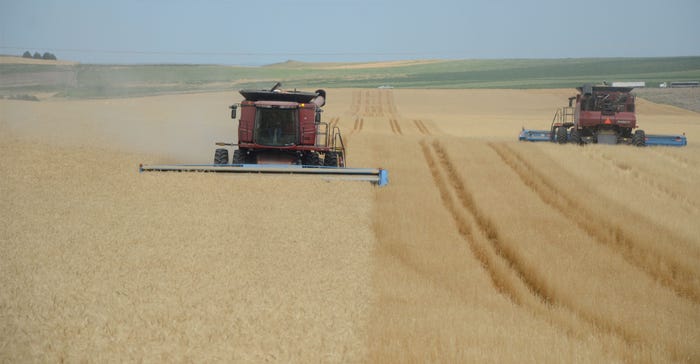
Mark Spurgin's Case IH combine rumbles up a mile-long stretch of wheat on the edge of the Nebraska Sandhills. His hands haven't touched the steering wheel, thanks to satellite row guidance technology. But after harvesting winter wheat for over 35 years, it's a hard habit to break.
The yield monitor reads a consistent 70 to 72 bushels per acre, and this field north of Ogallala has some of the highest yields he's seen this year. "This is probably the best field we're going to harvest. If we average 55 to 65 bushels per acre, we'll be doing pretty well," Spurgin says. "There are some 80-bushel averages, but most are probably from 60 to 65 bushels per acre."
However, this year wasn't without its challenges for winter wheat growers.
Royce Schaneman, executive director of the Nebraska Wheat Board, notes although this year didn't see the level of disease pressure as the last two years, wheat streak mosaic was still a big problem for growers, especially in the western part of the state. "This year, if you had a susceptible variety, especially in the southern Panhandle or the southwest corner of the state where the virus was most prevalent, you really saw some devastating losses in those areas," Schaneman says.
Fortunately, this wasn't a big problem in Spurgin's region of west-central Nebraska, and he took measures to control volunteer wheat last year to prevent wheat streak mosaic from occurring.
Many growers this year dealt with stripe rust, which quickly became prevalent across the state. Researchers have noted that after the third year of stripe rust in Nebraska, it appears the disease may be overwintering in the state.
"This year a lot of us sprayed fungicide; in fact, we sprayed twice," says Spurgin — once at topdress time and an aerial application at flag leaf. "We're lucky that the price of wheat went up a little, so that fungicide application will pay off more."
"We want to protect the flag leaf. The minute the flag leaf appears, we try to spray," he adds. "Two years ago we had stripe rust really bad, and we want to avoid that happening again. Sometimes it's better to make a preventive application than a curative one when you've already lost yield to stripe rust."
Schaneman notes that while the last two years have seen less-than-desirable protein levels, this year's protein levels, while not outstanding, were on average an improvement over last year.
"Last year, we had pretty decent moisture, excellent yield, and we had a lower protein because we didn't have heat or drought stress during grain fill," he says. "Our proteins are a little better this year. We'd really like them to be around 11.5% to 12.5%. We still have some low protein, but not as low as we've seen the last two years."
Nitrogen management may be one reason Spurgin saw higher protein levels and yield this year. He split-applies nitrogen on his wheat, with a starter application and a topdress, depending on soil nutrient needs.
Spurgin notes variety made a difference this year — as much as 10 to 15 bushels between the three varieties he harvested on his own acres, including Clearfield’s CL503, Westbred's WB Grainfield and Westbred's Winter Hawk. Depending on the variety, Spurgin harvested protein levels from 9.8% up to 13.1%.
Timely rains in May likely played a role in higher yields, while avoiding rains during grain fill in June may have contributed to ideal protein levels. "They say 0.30 inch of moisture at the right time makes a bad farmer look good, and that's true this year," Spurgin says.
Schaneman says, overall, wheat yields across the state have been highly variable, although when averaged out, are on par with the state average of 45 bushels per acre. Schaneman has heard anything from 35 bushels up to 100 bushels per acre. "Some people say it's the best harvest they've ever had, and other people say it's the worst. We probably hear that to a certain extent each year," says Schaneman.
About the Author(s)
You May Also Like






